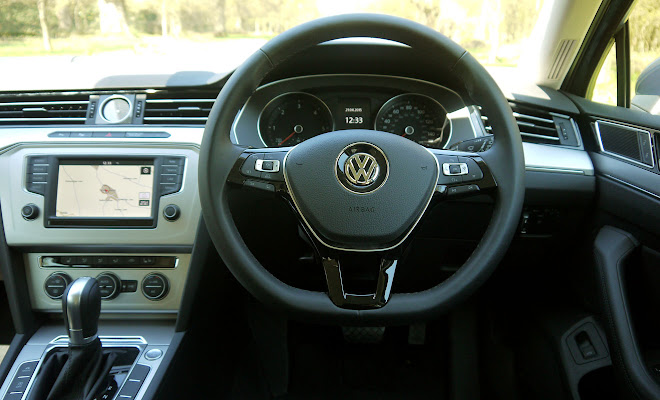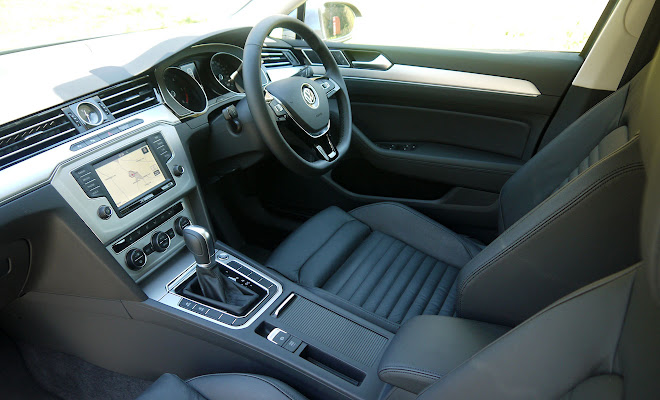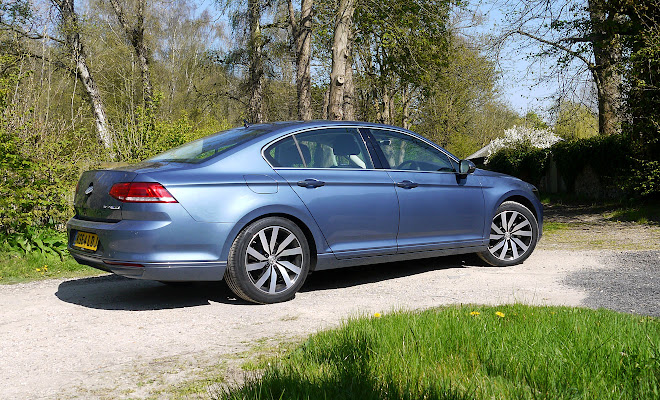by Lem Bingley 
This is presumably why the new Passat has acquired a kendo mask for a face, stretched as wide as a set of 1970s chest expanders. The new design links the headlamps and grille into a single grin from ear to ear, for a result about as wide as the Millennium Bridge. And VW will no doubt be hoping that this optical flourish will make the Passat seem as hunkered and purposeful as any BMW 3-Series.
You can make your own mind up on that one.

Inside, the full-width treatment continues with a single sweeping air-vent motif that spans the dashboard from door to door.
I’m sure this idea looked lovely in sketches but embodied in black and silver plastic it is, to my eye, deeply misguided. The trouble is that it’s fakery. An enormous faux vent within which real vents are hiding. It’s a feature that nibbles away at what ought to be VW virtues: plainness, quality and integrity.

Happily, the rest of the interior is a more impressive prospect, feeling much like an expanded Golf interior – which is no doubt very close to the case. Jump from a seventh-generation Golf to a Passat and you will spot big and small differences, of course, at least one of which is very welcome. The windscreen pillars seem slightly more slender in the larger car, which is always a bonus if you like to see out.
The central tunnel also seems a bit higher set, meaning you’ll feel more deeply seated in the Passat than in the Golf, even if the physical seating position isn’t actually much different. Again, I suspect this is less about structural necessity and more to do with creating an air of wraparound sportiness. You’ll also feel quite separated from your front seat passenger as a result, which may or may not be welcome, though the centre console is fairly shared in the Passat, not turned in towards the driver as it is in a Golf.

On the move, I can’t say the Passat feels particularly sporty or purposeful to me. It is, however, as peaceful as two earfuls of cotton wool and impressively comfortable too. Longer cars always feel more composed than shorter ones over a lumpy road, but even with this in mind the big VW does a swan-like job of floating over imperfections.
My test car is in SE Business trim, with a 2.0-litre EU6 diesel engine providing up to 150 horsepower and 340Nm of torque – which is enough brawn to make the Passat feel light and lithe. The dash to 62mph disappears in just 8.7 seconds, while the CO2 score is a miserly 106g/km.
This version of the Passat is likely to be the mainstay of the range, sold in bulk to fleets and destined to spend many hours devouring the outside lane. At motorway pace the interior is as peaceful as a Swiss chalet, with both engine rumble and tyre roar muffled below the whistle of wind around the mirrors.

You can pile on the miles in comfort, thanks to supportive cushions and plenty of adjustment in the seat and wheel.
The clever central touchscreen is another feature that will be familiar if you’ve ever sat in a seventh-generation Golf. I’ve used these screens enough now that I find their magical ability to detect and respond to an approaching finger almost as irritating as it is impressive. Yes, it is helpful to clear away the clutter of buttons when I’m not interacting with the screen but no, it’s not great that things change or move just when I’m about to prod them.
And, as with the Golf, I think you could argue that the touchscreen is mounted in the wrong place. It might be better brought level with the instrument panel, rather than half way down the central stack, all the better to flick your gaze at from the road and back.

The saloon I tested also came with Area View, a £755 option providing front, rear and side cameras to aid manoeuvring in tight spots. Cleverly, the rear camera is kept clean by spending most of its life hiding inside the flip-up VW door handle at the back.
There are a suite of driving profiles to choose from, which alter the character of the car quite a bit. Use the button by the gearlever or the on-screen options and you can decide among Comfort, Normal, Sport, Eco and a personalised mode where you can mix and match settings using a tick-the-box menu.

If you opt for the six-speed twin-clutch automatic, the modes will alter shift behaviour to either hang onto gears or short-shift, according to your sport or eco preferences. The six-speed manual gearbox is a perfectly good choice, however, offering a neat and clean action and saving £1,600 in the process.
Dynamic suspension, a £700 option, can also be tweaked from Comfort though Normal to Sport settings. Even with £665-worth of 18-inch alloys slapped onto the axles, the stiffest setting remains surprisingly compliant and tolerable, while Comfort feels feathery but never bouncy.
In the back of the Passat there’s further comfort on offer via a noticeably generous amount of room for lower limbs, helped by the new car’s lengthened wheelbase. The gap between the axles is about 8cm longer than in the prior Passat, while from bumper to bumper the the whole car is actually a whisker shorter than the Passat it replaces. It’s also up to 85kg lighter depending on the particular spec chosen, a finger-width lower and about the same amount wider.

Thankfully the estate version of the Passat has not gone all sporty and lifestyle and pointless. It looks reassuringly as if a big square box has been grafted on aft of the passenger compartment. Estate and saloon both measure the same from tip to tail, though the estate is fractionally taller. Its tailgate opens wide, there’s a low lip, and enough room inside to swing a pretty fearsome cat.
Spacious, comfortable, solid and with a reasonable turn of speed, the new Passat makes a very decent case for itself. But it’s not entirely persuasive as an athletic sports saloon. So it’s a shame that VW’s stylists have tried quite so hard to make the Passat look like something it’s not.


VW Passat
Rating: stars Good: spacious, frugal and comfortable
Bad: iffy styling both inside and out
Price: from £22,320
Car designers do love their horizontal lines. Stretched across a car’s visage, along its flanks or whipped across its derriere, an unbroken line tricks the eye into perceiving a big slab of metal and plastic as longer, lower or wider. And as a result, perhaps, the car as leaner, sportier and more purposeful than it actually is. Rating: stars Good: spacious, frugal and comfortable
Bad: iffy styling both inside and out
Price: from £22,320
This is presumably why the new Passat has acquired a kendo mask for a face, stretched as wide as a set of 1970s chest expanders. The new design links the headlamps and grille into a single grin from ear to ear, for a result about as wide as the Millennium Bridge. And VW will no doubt be hoping that this optical flourish will make the Passat seem as hunkered and purposeful as any BMW 3-Series.
You can make your own mind up on that one.

Inside, the full-width treatment continues with a single sweeping air-vent motif that spans the dashboard from door to door.
I’m sure this idea looked lovely in sketches but embodied in black and silver plastic it is, to my eye, deeply misguided. The trouble is that it’s fakery. An enormous faux vent within which real vents are hiding. It’s a feature that nibbles away at what ought to be VW virtues: plainness, quality and integrity.

Happily, the rest of the interior is a more impressive prospect, feeling much like an expanded Golf interior – which is no doubt very close to the case. Jump from a seventh-generation Golf to a Passat and you will spot big and small differences, of course, at least one of which is very welcome. The windscreen pillars seem slightly more slender in the larger car, which is always a bonus if you like to see out.
The central tunnel also seems a bit higher set, meaning you’ll feel more deeply seated in the Passat than in the Golf, even if the physical seating position isn’t actually much different. Again, I suspect this is less about structural necessity and more to do with creating an air of wraparound sportiness. You’ll also feel quite separated from your front seat passenger as a result, which may or may not be welcome, though the centre console is fairly shared in the Passat, not turned in towards the driver as it is in a Golf.

On the move, I can’t say the Passat feels particularly sporty or purposeful to me. It is, however, as peaceful as two earfuls of cotton wool and impressively comfortable too. Longer cars always feel more composed than shorter ones over a lumpy road, but even with this in mind the big VW does a swan-like job of floating over imperfections.
My test car is in SE Business trim, with a 2.0-litre EU6 diesel engine providing up to 150 horsepower and 340Nm of torque – which is enough brawn to make the Passat feel light and lithe. The dash to 62mph disappears in just 8.7 seconds, while the CO2 score is a miserly 106g/km.
This version of the Passat is likely to be the mainstay of the range, sold in bulk to fleets and destined to spend many hours devouring the outside lane. At motorway pace the interior is as peaceful as a Swiss chalet, with both engine rumble and tyre roar muffled below the whistle of wind around the mirrors.

You can pile on the miles in comfort, thanks to supportive cushions and plenty of adjustment in the seat and wheel.
The clever central touchscreen is another feature that will be familiar if you’ve ever sat in a seventh-generation Golf. I’ve used these screens enough now that I find their magical ability to detect and respond to an approaching finger almost as irritating as it is impressive. Yes, it is helpful to clear away the clutter of buttons when I’m not interacting with the screen but no, it’s not great that things change or move just when I’m about to prod them.
And, as with the Golf, I think you could argue that the touchscreen is mounted in the wrong place. It might be better brought level with the instrument panel, rather than half way down the central stack, all the better to flick your gaze at from the road and back.

The saloon I tested also came with Area View, a £755 option providing front, rear and side cameras to aid manoeuvring in tight spots. Cleverly, the rear camera is kept clean by spending most of its life hiding inside the flip-up VW door handle at the back.
There are a suite of driving profiles to choose from, which alter the character of the car quite a bit. Use the button by the gearlever or the on-screen options and you can decide among Comfort, Normal, Sport, Eco and a personalised mode where you can mix and match settings using a tick-the-box menu.

If you opt for the six-speed twin-clutch automatic, the modes will alter shift behaviour to either hang onto gears or short-shift, according to your sport or eco preferences. The six-speed manual gearbox is a perfectly good choice, however, offering a neat and clean action and saving £1,600 in the process.
Dynamic suspension, a £700 option, can also be tweaked from Comfort though Normal to Sport settings. Even with £665-worth of 18-inch alloys slapped onto the axles, the stiffest setting remains surprisingly compliant and tolerable, while Comfort feels feathery but never bouncy.
In the back of the Passat there’s further comfort on offer via a noticeably generous amount of room for lower limbs, helped by the new car’s lengthened wheelbase. The gap between the axles is about 8cm longer than in the prior Passat, while from bumper to bumper the the whole car is actually a whisker shorter than the Passat it replaces. It’s also up to 85kg lighter depending on the particular spec chosen, a finger-width lower and about the same amount wider.

Thankfully the estate version of the Passat has not gone all sporty and lifestyle and pointless. It looks reassuringly as if a big square box has been grafted on aft of the passenger compartment. Estate and saloon both measure the same from tip to tail, though the estate is fractionally taller. Its tailgate opens wide, there’s a low lip, and enough room inside to swing a pretty fearsome cat.
Spacious, comfortable, solid and with a reasonable turn of speed, the new Passat makes a very decent case for itself. But it’s not entirely persuasive as an athletic sports saloon. So it’s a shame that VW’s stylists have tried quite so hard to make the Passat look like something it’s not.




